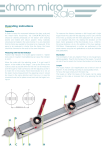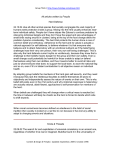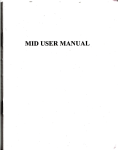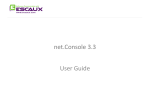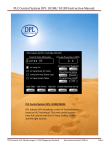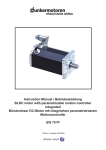Download iMSO-104 Manual
Transcript
iMSO-104 Manual Revised July 19, 2012 iMSO-104 Manual Table of Contents Section 1 – Getting Started – SAFETY 1.10 Quickstart Guide 1.20 SAFETY 1.30 Compatibility 1.31 Hardware 1.32 Software Section 2 – How it works 2.10 Menus 2.20 Analog Channel 2.21 On / Off 2.22 1x / 10x Probe 2.23 DC / AC Coupling 2.24 Reference Wave 2.25 Recenter 2.26 FFT On / Off 2.30 Digital Channel 2.31 On / Off 2.32 Reference Wave 2.40 Cursors 2.41 On / Off 2.42 Axis 2.43 Mode 2.44 Horizontal Cursors 2.45 Vertical Cursors 2.46 FFT Units 2.50 Measurements 2.60 Trigger 2.61 Analog Triggering 2.62 Digital Triggering 2.63 Auto vs Normal 2.64 Delay 2.65 Holdoff 2.66 Single-shot Waveform Capture 2.71 Functions 2.72 Amplitude 2.73 Frequency 2.74 DC Offset 2.75 Duty Cycle 2.81 Grid Settings 2.82 Alerts 2.83 Persistence 2.84 Sounds 2.85 Calibration 2.86 Screenshot 2.87 Email 2.88 Manage Data Log 2.89 Configuration Settings 2.70 Demo 2.80 Settings 2.90 Host Properties Section 3 – Product Warranty & Accessories 3.10 Manufacturers Warranty 3.20 Accessories 3.21 1x / 10x Analog Probe 3.22 Logic Harness 3.23 SMD Grabbers 3.24 Screwdriver Section 4 – Performance 4.10 Detailed Specifications 4.20 Performance Optimization Section 5 – How to Contact Us Revised July 19, 2012 2 Section 1 – Getting Started 1.10 Quickstart Guide Quickstart Guide Oscium iMSO-104 Mixed Signal Oscilloscope 30 PIN DOCK CONNECTOR CONNECT TO APPLE DEVICE SCOPE A N A L O G PR O B E LOGIC PROBE 1) Download “iMSO” from the app store. 2) Connect the scope to the iPod Touch®, iPhone®, or iPad™ using the 30 pin dock connector. Note: Blue light indicates that scope is communicating with the application. 3) Connect Analog Probe and Logic Probe to the appropriate ports on the scope. 4) For more information, please visit the Oscium website. www.oscium.com “Made for iPod”, “Made for iPhone”, and “Made for iPad” means that an electronic accessory has been designed to connect specifically to iPod, iPhone, or iPad, respectively, and has been certified by the developer to meet Apple performance standards. Apple is not responsible for the operation of this device or its compliance with safety and regulatory standards. Please note that the use of this accessory with iPod, iPhone, or iPad may affect wireless performance. Revised July 19, 2012 3 iMSO-104 Manual 1.20 SAFETY The maximum voltage limit for the analog probe in 1x mode is -8v / +13v, and the maximum voltage limit in 10x mode is -40V / +40V. The maximum voltage limit for the digital channels is -.0.5v to +7v. Oscium is not held liable for usage outside of these limits. 1.30 Compatibility 1.31 Hardware iMSO is the world’s first mixed signal oscilloscope for iOS! At this time, it works on these specific Apple® devices: iPod touch (1st, 2nd, 3rd and 4th generation) iPhone 4 iPhone 3GS iPhone 3G iPhone iPad 2 iPad 1.32 Software iOS version 3.1.3 or newer is required for iMSO to operate. iMSO is available for free to download in the App Store. Revised July 19, 2012 4 Section 2 – How It Works 2.10 Menus The manual describes how iMSO works on the iPad, iPhone and iPod touch. iPad | iPhone | iPod touch The menu bar can be hidden or revealed by sliding the word center of the screen. The Summary Bar up or down. is located at the bottom The Menu Bar The menu bar has sub menus that can be selected by touching the appropriate word or icon. When hardware is not connected a ‘demo mode’ watermark appears and the following options exist in the menu bar: When hardware is connected, changes to . And the watermark ‘demo’ disappears. Revised July 19, 2012 5 iMSO-104 Manual iPad | iPhone | iPod touch 2.20 Analog Channel The green signal always represents the analog channel. Simply touch the green bubble on the left. Leave your finger on the bubble and move the channel position either up or down. 2.21 Analog Channel On / Off Tap on the menu bar. The channel can be turned either on or off at the top of the menu by tapping either or . 2.22 Analog Channel 1x / 10x Probe The analog probe has a sliding red lever that allows the user to move between 1x and 10x modes. Once a mode is selected on the analog probe, chose the matching state by selecting either or . The selected state will be gray and the unselected state will be translucent. 2.23 Analog Channel DC / AC Coupling When current is flowing in the same direction all the same, tap . When current is changing directions, tap . The selected state will be gray and the unselected state will be translucent. 2.24 Analog Channel Reference Wave Touch on the menu bar. Then, touch to create a reference wave for the analog channel. When a wave has been captured, will change to and will change to . Once the wave has been captured, it is saved and available for future use by pressing reference. The reference wave will appear as a white wave and will appear to the far left of that wave. The outer color of this bubble will match the color of the wave that has been referenced. To clear the reference wave tap the word clear. 2.25 FFT On/Off Touch on the menu bar. At the bottom of the menu, FFT appears. to turn FFT on, touch and it will change to . The reference wace will appear as a red wave and will appear to the far lef tof that wave. To turn FFT off, touch and it will turn to indicating FFT is deactivated 2.30 Digital Channel The purple, yellow, blue and orange signals represent the four digital channels. Simply touch the far left bubble of the desired digital signal. Leave your finger on the bubble and move the channel position either up or down. 2.31 Digital Channel On / Off Tap on the menu bar. The following menu will appear: Revised July 19, 2012 6 iPad | iPhone | iPod touch Each channel can be turned either on or off by tapping either or 2.32 Digital Channel Reference Wave Tap on the menu bar. Then, touch to create a reference wave for the desired digital channel. When a wave has been captured, Ref will change from to and capture will change from to . Once the wave has been captured, it is saved and available for future use by pressing . The reference wave will appear as a white wave and will appear to the far left of that wave. The outer color of this bubble will match the color of the wave that has been referenced. To clear the reference wave tap . 2.40 Cursors 2.41 Cursors On / Off Tap on the menu bar. Tap to activate cursors. 2.42 Cursor Axis Then, tap either the cursor or the cursor. Select which signal to view by tapping the bubble on the far left of that signal. For example, if D1 is selected, which is the purple signal, the cursors will change to purple. Then, if D2 is selected, the cursors will change to yellow to match the color of D2, which is yellow. After selecting the appropriate signal, double tap the interfacae until the summary screen appears. Metrics relating to the cursors appear in the center of the summary screen and in the color of the signal that is being viewed. 2.43 Cursor Mode There are two modes available on this device: and . Upon activating cursors, two lines will appear. One is dotted and the other is solid. The solid line is active and can be moved by touching the line and while holding that line moving it either up or down. While in tracking mode both the solid and dotted lines will move together. In independent mode the solid line is the only line that can be moved. Additionally, dynamic metrics related to the solid line are available in the summary screen located at the bottom (and in the color of the selected channel). Tap on the dotted line and it will become a movable solid line, while the other line will change to dotted. 2.44 Horizontal Cursors Tap the icon from the menu bar. Tap to activate cursors. Tap from the cursors menu and it will change from turn the horizontal cursors on and off respectively. to . Tap and to On the main screen, touch and swipe the desired cursor in the vertical direction and place where desired. The selected cursor will be displayed as a solid line and the un-selected cursor, a dashed line. The position of the selected cursor is indicated next to @V in the summary bar. The distance between the two cursors is indicated next to ∆V in the summary bar. 2.45 Vertical Cursors Tap the icon from the menu bar. Tap to activate cursors. Tap from the cursors menu. On the Revised July 19, 2012 7 iMSO-104 Manual iPad | iPhone | iPod touch main screen, touch and swipe the desired cursor in the horizontal direction and place where desired. The selected cursor will be displayed as a solid line and the un-selected cursor, a dashed line. The position of the selected cursor is indicated next to @t in the summary bar. The distance between the two cursors is indicated next to ∆t in the summary bar. The voltage level at the point where the selected cursor crosses the waveform is indicated in the summary bar next to @V and the vertical difference between the crossing points of the two vertical cursors is indicated in the summary bar next to ∆V. When using vertical cursors with the analog channel both @t, t and @V, V will be visible in the summary bar. Verify that cursors are selected. To move cursors independently of one another, tap cursors as a single unit with a fixed distance between them, tap . To move . The following options are available: . 1.If cursor data is to be displayed in Base, tap Time settings available in the Base option include: option sets the unit of measure in hertz. 2. If cursor metrics are to be displayed in Phase, tap phase. The option of . The options next to the word UNIT set the unit of time. . The option sets the unit of measure in seconds. The sets 360° within 5 divisions. The . The options next to the phrase 360° WITHIN sets the option sets 360° between the two cursors. 3. If cursor data is to be displayed as a ratio, tap . The options next to the phrase 100% WITHIN set the ratio. Ratio settings available next to 100% WITHIN include: . The option of sets 100% within 5 divisions. Since there are 10 divisions in the horizontal time scale, this option effectively cuts the screen in half. The option sets 100% between the two cursors. 2.46 FFT Units Tap the icon from the menu bar. The options next to the phrase FFT Units will set the voltage units. Voltage options available in the FFT Units option include and . By tapping the option the voltage units will display as volts in the summary bar. Tapping the option will change the voltage units to dBv. 2.50 Measurements Tap from the menu bar. Fifteen different measurements exist: Min, Max, Mean, Peak to Peak, RMS, Duty Cycle (+), Duty Cycle (-), Pulse Width (+), Pulse Width (-), Cycle Mean, Cycle RMS, Frequency, Period, Rise Time, and Fall Time. To scroll through the measurement options, tap . Then, scroll thorugh the pick wheel to choose the desired measurements. To activate the settings tap away from the menu or tap . Up to six measurements can be selected simultaneously. Measurements appear on the top right of the interface. Revised July 19, 2012 8 iPad | iPhone | iPod touch 2.60 Trigger 2.61 Analog Triggering The trigger level is controlled with located on the far right of the screen. Touch and drag the bubble either up or down. Moving the level up will increase the voltage level and moving it down will decrease the voltage level. The exact voltage level will appear just to the left of the bubble along with either an up arrow or a down arrow. An up arrow indicates that the trigger is on a rising edge; a down arrow indicates that the trigger is on a falling edge. It is also possible to change the trigger level in the advanced triggering menu. Tap and, when active, it will change . Then tap to . To navigate to an exact trigger level tap on should then appear. next to the word LEVEL. The analog trigger level pick wheel To select the desired trigger level touch and drag in each of the four columns until the specific value is reached. To activate the settings tap away from the menu or tap . When analog triggering has been enabled, then all the advanced options for digital triggering will be grayed out. To reactivate the analog trigger, tap . If the analog triggering is grayed out, it is disabled. Then tap any of the options on the picture below and it will no longer be grayed out. Analog triggering is always available in demo mode; it is not possible to deactivate until hardware is used. To trigger off of a rising edge, tap . If rising is already activated it will look like , this means that falling is deactivated, because both falling and rising cannot be active at the same time. If it is deactivated it will look like , and falling is activated. tap it once and it will activate to . To trigger off a falling edge the same Revised July 19, 2012 9 iMSO-104 Manual iPad | iPhone | iPod touch procedure should be followed. Falling should look like when activated and when deactivated. To recenter your trigger level, tap and your signal will be brought in line with CH A. 2.62 Digital Triggering This feature is only available with hardware; it is not available in demo mode. When in demo mode all the digital triggering options are grayed out. 1. Tap from the menu bar. Then tap at the top of the menu to view more advanced digital triggering options. All the options may be grayed out (because analog and digital triggering can’t both be active at the same time). If analog is grayed out, digital is active and vice versa. To activate the desired trigger, tap one of the advanced triggering options. Then, the option that is tapped will activate. From the menu, select the desired triggering function from these options: single channel only , simultaneous events on two channels , a single event on one of two channels , or concurrent events on two channels . 2. Below the selected triggering functions tap A and B, respectively. or to select the digital channel from D1 to D4 to be used as channels 3. After locating the desired digital channel, tap and when activated, it will change to . In the previous example, channel A is now D4. Now, the bubble that appears on the far left of D4 will have an A inside . The A indicates that D4 is now A. Repeat the same process for B, when applicable. 4. To choose whether triggering occurs on a rising or falling edge, either select rising edge. for a falling edge or select for a 2.63 Auto vs Normal Tap . Then tap . Tap the desired mode, either AUTO or NORMAL. For example, if activating AUTO mode tap and it will change to . Repeat the process for NORMAL mode. The default setting is AUTO . 2.64 Delay To set the trigger delay from the main screen, touch the screen and swipe horizontaly to move the trigger point. The bottom portion will detach from the top to set the trigger position. Revised July 19, 2012 10 iPad | iPhone | iPod touch To set the trigger delay from the trigger menu, tap then select and press pick wheel will appear that allows you to set the delay time to the value shown in the readout. located next to DELAY. A To select the desired trigger delay touch and drag in each of the four columns until the specific value is reached.To activate the settings tap away from the menu or tap . 2.65 Holdoff Tap Tap in the menu bar to enter the trigger menu. . Tap next to HOLDOFF to set the holdoff time. Setting the Holdoff value should be done in the same manner as the delay. 2.66 Single-Shot Waveform Capture If the signal is active, the screen can be paused by tapping . Pause is located in the menu bar, on the far right side. If the signal is paused, the screen will resume real time measurements by tapping . In order to capture a single-shot wave form touch and hold or until it changes to . Then tap , it will then capture a single-shot waveform. Remember that in order to trigger off a specific event make sure that the setting is normal. If it is set to auto you will just get the next frame, not the next event. 2.70 Demo 2.71 Demo Functions When no hardware is attached, iMSO will operate in Demo Mode. Demo Mode is illustrated in the bottom right corner by . When hardware is attached, Demo Mode is not available; iMSO will now be in Active Mode. Active Mode is illustrated in the bottom right corner by . While in Demo Mode, tap to change the function that is being viewed. Although four different wave forms can be viewed on Channel A, only one waveform can be viewed at any time. To change the wave form being viewed, tap then pick the desired waveform in the pick wheel. To activate the setting tap away from the menu or tap . Revised July 19, 2012 11 iMSO-104 Manual iPad | iPhone | iPod touch 2.72 Demo Amplitude Tap from the menu bar on the right. To change the of the signal tap located to the right of . Enter the desired voltage using the pick wheel. To activate the setting tap away from the menu or tap . 2.73 Demo Frequency Tap from the menu bar on the right. To change the of the signal, tap located to the right of . The pick wheel pops up and it is now possible to modify the frequency by selecting the desired frequency. Frequencies can be entered in Hz, kHz, or MHz. To activate the settings tap away from the menu or tap . 2.74 Demo DC Offset Tap from the menu bar. To set the DC offset, tap located to the right of voltage offset from the pick wheel. To activate the settings tap away from the menu or tap . Then select the desired . 2.75 Duty Cycle In order to change the Duty Cycle, the demo mode must be set to . Once the demo mode is switched to square the Duty Cycle option will change from to . To change the of the signal, tap . Enter the desired voltage using the pick wheel. To activate the setting tap away from the menu or tap . Revised July 19, 2012 12 iPad | iPhone | iPod touch 2.80 Settings iPhone/iPod Touch- When hardware is connected, dissapears and is replaced by setting are unlocked. In order to change the settings while in demo mode, touch and hold iPad- appears in the main menu bar. When hardware is connected are unlocked. . Then all additional until it changes to . dissapears. Then all additional settings 2.81 Grid Settings Lines vs. Dots Tap . Then tap the desired selection, either or . This setting affects the way that the signals are displayed; it will either be point by point (dots) or it will be represented with a line. Graticule Tap . Then tap or to scroll through the various background display options. They include: Crosshairs, Major Tics, Minor Tics, Major Grid, Minor Grid, and finally Graticule. Once a selection is tapped it becomes active and changes from . Tapping graticule is a shortcut for tapping all of the above. to 2.82 Alerts Tap, . Three alerts are available. They are located on the third row from the top: ALERTS, ON STARTUP & ON DISCONNECT. Cycle through the options by tapping or next to the selection. Then tap the selection to activate it. To deactivate a specific alert, tap the alert and it will change from to . Tapping is a shortcut for tapping all of the above. 2.83 Persistence Tap . Then tap and swipe the dot to the right of persist to , tap persistence off, tap . For the advanced options relating . Digital persistence can either be turned off or on. To turn it on, tap . . To turn digital 2.84 Sounds Sounds can be controlled either through hardware or software. The Apple device can control the sound (in the same way it always controls sound) by using the plus/minus volume controls on the side of the device. In the software, sounds are turned off by tapping . Then tap SOUNDS and it will either turn sounds on or off . 2.85 Calibration The iMSO is shipped fully calibrated. If, for any reason, the analog input ever slips out of calibration, the iMSO can easily be re-calibrated from a built in 3.3 V, 1 kHz reference signal. Tap from the menu bar. From the setting menu, tap to enable the 3.3 V calibration signal. When the signal is activated changes to . Next, select on the menu bar and ensure is selected. Insure the switch on the analog probe is switched to 1x. Connect the SMD grabber for GND (or the black wire) to the ground clip for the analog probe. Revised July 19, 2012 13 iMSO-104 Manual iPad | iPhone | iPod touch Remove the connector attachment from the analog probe. Then connect the SMD grabber for D1 (or the purple wire) to the tip of the analog probe. 2.86 Screenshot Two options exist. First, a screenshot can be captured by simultaneously pressing both the home button and the power button on your Apple device. The screen will flash white while the picture is captured. When a picture is captured this way, everything visible on the LCD will be captured and available in photos. The second option is to tap and then tap . The text SCREENSHOT will fade to from black to gray and the display will briefly change to full screen mode. Although this is a very useful method, it may not always be the best way to take a screenshot. By simultaneously pressing the home and the power button, it is possible to take a picture of exactly what is on the screen. In some cases, this will be the best option. 2.87 Email Tap . Then, tap . The email will consist of the image currently displayed on the screen. Although it is not possible to retrieve screenshots from this spot, the pictures are still available in photos where they can be emailed. The other option is to simultaneously press both the home button and the power button on your Apple device. The screen will flash white while the picture is captured. When a picture is captured this way, everything visible on the LCD will be captured and available in photos where they can be emailed. 2.88 Manage Data Log This feature is only available with hardware; it is not available in demo mode. When in demo mode the data logging options for DATA LOG: START and STOP are grayed out. Tap from the menu bar. Then tap from the data log option, in order to indicate data is being logged. To stop data logging tap . will then change to . Tap . Then tap . A pick wheel will appear with all of the data that has been previously logged. To select precious data log tap away form the menu or tap . Revised July 19, 2012 14 iPad | iPhone | iPod touch 2.89 Configuration Settings Reset Configurations To reset the configuration, tap . Then tap, . Saving Configurations Up to three configurations can be saved at a time. Tap . Then tap next to CONFIG 1, 2 or 3. turn to and then back to , indicating the configuration has been successfully saved. To upload a saved configuration tap . indicating the configuration has successfully been loaded. Will turn to and then back to will , 2.90 Host Properties From Demo Mode, tap . from the bottom right corner of the menu screen to view host properties. When hardware is plugged in and product is in Active Mode, tap from the bottom right corner of the menu screen to view host properties. Here is an example of host properties on an iPhone: iOS version 3.1.3 or newer is required for iMSO to operate. Revised July 19, 2012 15 iMSO-104 Manual Section 3 – Product Warranty & Accessories 3.10 Product Warranty iMSO hardware comes with a full one year manufacturer’s warranty. No warranty exists on probes and accessories. 3.20 Accessories iMSO-104 comes with the following accessories: 1x / 10x analog probe, logic harness, five SMD grabbers, and one screwdriver. 3.21 1x / 10x Analog Probe The analog probe is capable of measuring signals up to 100MHz and can operate in either 1x or 10x mode. It is removable with an SMB connector. 3.22 Logic Harness The logic harness is has five colors: purple (D1), yellow (D2), blue (D3), orange (D4), and black (ground). The colors on the harness match up with the colors on the interface. If a user is color blind, the harness colors are labeled D1, D2, D3, D4, and GND on the back of the iMSO hardware 3.23 SMD Grabbers SMD grabbers have the Oscium flame custom built into the front. 3.24 Screwdrivers The screwdriver is custom made for iMSO and is used for calibrating the device. Revised July 19, 2012 16 Section 4 – Performance Specifications iMSO-104 iPad 1-3rd Gen iPod Touch/iPhone Display 9.7" 3.5" 3.5" Resolution Analog 1024x768 600x400 960x640 1 Channel, 8 bit 1 Channel, 8 bit 1 Channel, 8 bit Analog Probe 100MHz, (1x & 10x selectable), removable with SMB 100MHz, (1x & 10x selectable), removable with SMB 100MHz, (1x & 10x selectable), removable with SMB 4 4 bits, 1 Gnd, 0.100" connectors with removable SMD Grabbers 5MHz 4 4 bits, 1 Gnd, 0.100" connectors with removable SMD Grabbers 5MHz 4 4 bits, 1 Gnd, 0.100" connectors with removable SMD Grabbers 5MHz 12MSPS 12MSPS 12MSPS Horizontal Sensitivity 240pts 240pts 240pts 2uS/div-1S/div 2uS/div-1S/div 2uS/div-1S/div Trigger Position Adjustable Adjustable Adjustable Adjustable Adjustable Adjustable Vertical Sensitivity 50mV/div to 2v/div (1x) 500mV/div to 20v/div (10x) 50mV/div to 2v/div (1x) 500mV/div to 20v/div (10x) 50mV/div to 2v/div (1x) 500mV/div to 20v/div (10x) Vertical Position Digital Digital Probe Analog Bandwidth Max Sample Rate Sample Depth Horizontal Position 4th Gen iPod Touch/iPhone Max Digital Input Voltage Adjustable Adjustable Adjustable -0.5v to +7v -0.5v to +7v -0.5v to +7v Max Input Voltage -8v to +13v (1x) -40v to +40v (10x) -8v to +13v (1x) -40v to +40v (10x) -8v to +13v (1x) -40v to +40v (10x) Coupling AC or DC AC or DC AC or DC Trigger Modes Auto/Normal/Single/Stop Auto/Normal/Single/Stop Auto/Normal/Single/Stop Trigger Types Analog, Digital (A, A&B, A|B, A->B) Analog, Digital (A, A&B, A|B, A->B) Analog, Digital (A, A&B, A|B, A->B) Live Measurements Measurement Types Features 6 6 6 Frequency Frequency Frequency Period Period Period Min Min Min Max Max Max Mean Mean Mean Peak to Peak Peak to Peak Peak to Peak RMS RMS RMS Positive Duty Cycle Positive Duty Cycle Positive Duty Cycle Negative Duty Cycle Negative Duty Cycle Negative Duty Cycle Positive Pulse Width Positive Pulse Width Positive Pulse Width Negative Pulse Width Negative Pulse Width Negative Pulse Width Cycle Mean Cycle Mean Cycle Mean Cycle RMS Cycle RMS Cycle RMS Rise Time, Fall Time Rise Time, Fall Time Rise Time, Fall Time Screen Capture -> Email Screen Capture-> Email Screen Capture-> Email Demo mode (Analog) Horizontal/Vertical Cursor Measurements Demo Mode (Analog) Horizontal/Vertical Cursor Measurements Demo Mode (Analog) Horizontal/Vertical Cursor Measurements Delay (always on) ~99.99s max Delay (always on) ~99.99s max Delay (always on) ~99.99s max Holdoff ~99.99s max Holdoff ~99.99s max Holdoff ~99.99s max Reference Capture FFT & Data Logging Reference Capture FFT & Data Logging Reference Capture FFT & Data Logging Revised July 19, 2012 17 iMSO-104 Manual 4.11 Performance Optimization Newer generations of Apple hardware will improve the Oscium customer experience. Animations will be faster and crisper. Multitasking can also affect performance. Turning off applications will improve performance. Double click the home button on your Apple device. All the applications listed in this menu are currently running on the device. Press and hold any icon. They will begin to shake and a minus sign will appear on the top left corner of the app. Tapping the minus sign will shut down the app; it will not delete it from your device. This will free up additional processing power on your device to maximize the user experience but it will only work on 3rd generation devices and newer. Section 5 – How to Contact Us Please let us know your thoughts about our newest product, iMSO! The best way to reach us is at www.oscium.com. Send us a technical question or just say hi. Product updates and new product releases will be available first on our twitter and facebook pages. Thank you for your interest in iMSO! Revised July 19, 2012 18


















